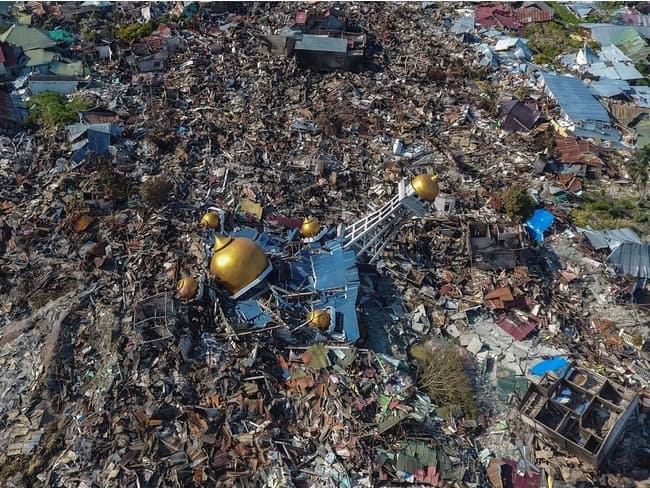Palu: More than a thousand people could still be missing after Indonesia’s devastating quake-tsunami, officials said Friday, drastically upping the number of people unaccounted for a week after the disaster.
Palu city on Sulawesi island has been left in ruins after it was hit by a powerful quake and a wall of water which razed whole neighbourhoods to the ground, with the official death toll now 1,571.
The number of confirmed missing stands at over 100, but fears are growing that vast numbers of people have been buried in a massive government housing complex at Balaroa, where the sheer force of the quake turned the earth temporarily to mush.
“Maybe more than 1,000 people are still missing,” Yusuf Latif, a spokesman for Indonesia’s search and rescue agency, told AFP.
“But we still cannot be sure because there’s a possibility that some people managed to get out.”
After days of delays, international aid is slowly making its way to the disaster zone, where the UN says almost 200,000 people need humanitarian assistance.
– ‘Racing against time’ –
Survivors have ransacked shops and supply trucks in the hunt for basic necessities, prompting security forces to round up dozens of suspected looters and warn that they will open fire on thieves.
Children with plastic containers begged for money by the roadside while some shell-shocked residents scoured for anything still salvageable among the debris.
“We’re racing against time,” said Dwi Sulaksono, commander of the navy base in Makassar, as supplies were unloaded from an Indonesian warship.
“We have to distribute supplies as quickly as possible, especially to remote areas.”
Authorities previously set a deadline of Friday for finding anyone trapped under ruined buildings, although chances of pulling survivors alive from the rubble at such a late stage are almost zero.
– ‘Doomsday’ –
Survivor Risa Kusuma, who had just moved to Palu with her family to escape Indonesia’s chaotic capital, recounted the horror of the twin calamities.
As massive tremors threw the family around like rag dolls, the terrified family of five managed to tumble out of their house and run along asphalt roads that were splitting under their bare feet.
“I thought it was doomsday,” the 35-year-old told AFP, days after she and her three children made it back to Jakarta on a flight out of the disaster-stricken region.
Some roads remain impassable, detritus from the tsunami is scattered everywhere, and terrified people are sleeping outside in makeshift camps for fear of more quakes.
Improvised white flags — a pillowcase or duvet cover — fly outside many homes, signifying a death in the family.
– Years to recover –
Nevertheless there were signs of life returning to normal, with children playing in the streets, radios blaring out music, and electricity back up and running in most places.
“Things are improving,” Azhari Samad, a 56-year-old insurance salesman, told AFP at a mosque in Palu.
But for the area to recover fully from the disaster “will take years”, he added.
“The first six months will be traumatic, maybe in one year we have some progress. The government will help, people will help from all over the country. Indonesians have a big heart.”
A state of emergency could be extended for a couple of months “until people in Palu can stand on their own”, Indonesian vice president Jusuf Kalla said during a visit to the shattered city.
“Places that can no longer be inhabited like Balaroa must be relocated,” he added.
Friday prayers in the world’s biggest Muslim-majority country took on a special significance after the tragedy. There were poignant scenes in Palu as hundreds of worshippers wearing skullcaps gathered by the coast, chanting and saying prayers out to sea.
In the city’s shattered Baiturrahman mosque — whose green dome collapsed into the prayer hall — 62-year-old Adan Abdurazak stood in tears in the place of worship where he had said his Friday prayers every week for the past 15 years.
“I’m still confused,” he said, when asked where he will pray now.
– Aid flow –
Getting vital supplies to the affected areas has proved hugely challenging, with the number of flights able to land at Palu’s small airport still limited, leaving aid workers facing gruelling overland journeys.
An AFP journalist saw long convoys of vehicles packed with supplies heading along a coastal road to Palu from the city of Mamuju, a 10-hour drive.
After initially refusing outside help, Indonesia reluctantly agreed to foreign aid, and 20 planes carrying items including tarpaulins, medical equipment and generators are heading from all over the world to the disaster zone.
Governments from Australia to Britain are flying in supplies, the United Nations has pledged $15 million to the relief effort, and aid groups including Save the Children and the Red Cross are also on the ground.
Indonesia sits along the Pacific “Ring of Fire”, the world’s most tectonically active region, and its 260 million people are vulnerable to earthquakes, tsunamis and volcanic eruptions.
[source_without_link]Agence France-Presse[/source_without_link]

